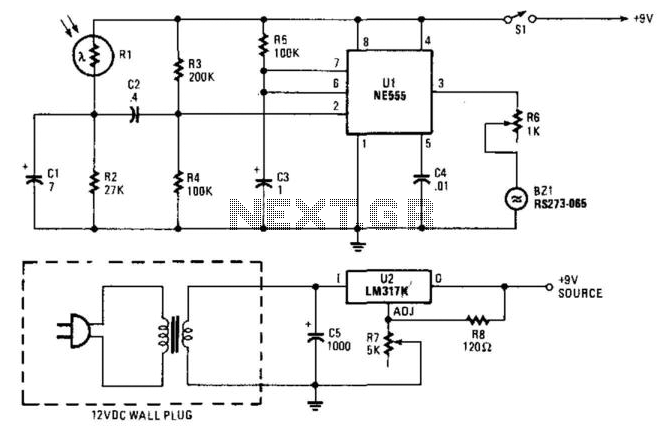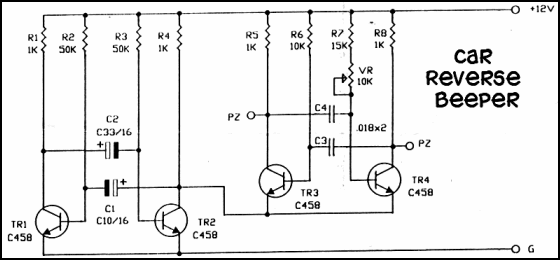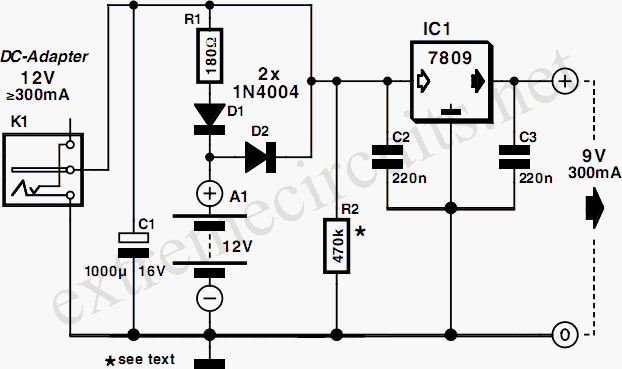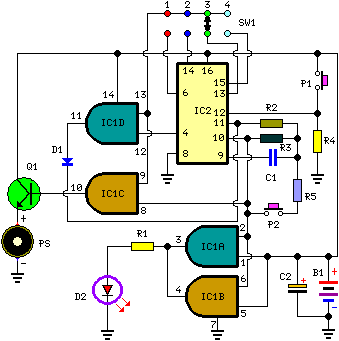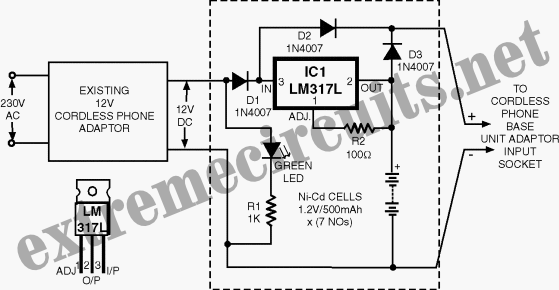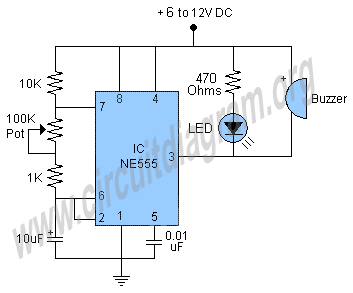
Backup Beeper
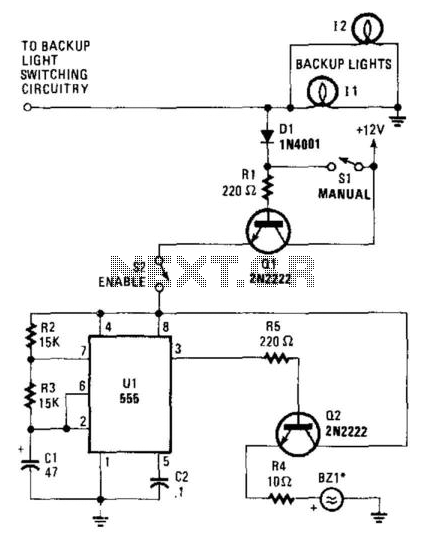
When the vehicle's backup lights are activated, or when the manual switch (SI) is closed, a small current is supplied to the base of Q1. Transistor Q1 allows current to flow through it and, if the enable switch (S2) is closed, it sends 12 V to U1, a 555 timer. Timer U1 generates high pulses lasting 0.97713 seconds and low signals lasting 0.488565 seconds to the base of Q2. When U1 activates Q2, it sends 12 V to BZ1, a piezoelectric buzzer. For optimal performance, the buzzer should be installed under the vehicle in a location where it can be easily heard by individuals nearby.
The described circuit is designed to provide an audible warning when a vehicle is in reverse. The operation begins with the activation of the vehicle’s backup lights or the manual switch (SI). This action allows a small current to flow into the base of transistor Q1, which acts as a switch that controls the larger current flowing through the circuit.
When Q1 is activated, it allows current to pass through to the enable switch (S2). If switch S2 is closed, it energizes the 555 timer (U1) with a supply voltage of 12 V. The 555 timer is configured in astable mode, producing a continuous square wave output. The timer generates high pulses of approximately 0.97713 seconds and low signals of about 0.488565 seconds. These pulses are directed to the base of transistor Q2.
Transistor Q2 functions as a power amplifier in this circuit. When it receives the signal from the 555 timer, it switches on, allowing a higher current to flow from the power supply to the piezoelectric buzzer (BZ1). The buzzer is designed to emit sound when supplied with this current, thereby alerting individuals in proximity to the vehicle that it is in reverse.
For effective sound projection, it is recommended that BZ1 be mounted in a location under the vehicle where the sound can travel unobstructed. This ensures that the warning beeps are audible to pedestrians and other drivers, enhancing safety during reversing maneuvers. Proper placement of the buzzer is critical for maximizing the effectiveness of the warning system. When the vehicle"s backup lights kick on, or when the manual switch (SI) is closed, a small current is fed to the base of Ql. Transistor Ql allows current to flow through it and, if the enable switch (S2) is closed, it sends 12 V to Ul, a 555 timer. Timer Ul sends high pulses that last 0.97713 s and low signals that last 0.488 565 s to the base of Q2.
When Ul switches Q2 on, it sends 12 V to BZ1, a piezoelectric buzzer. For best results, the buzzer should be mounted under the vehicle—somewhere where people around the car can hear the warning beeps. 🔗 External reference
The described circuit is designed to provide an audible warning when a vehicle is in reverse. The operation begins with the activation of the vehicle’s backup lights or the manual switch (SI). This action allows a small current to flow into the base of transistor Q1, which acts as a switch that controls the larger current flowing through the circuit.
When Q1 is activated, it allows current to pass through to the enable switch (S2). If switch S2 is closed, it energizes the 555 timer (U1) with a supply voltage of 12 V. The 555 timer is configured in astable mode, producing a continuous square wave output. The timer generates high pulses of approximately 0.97713 seconds and low signals of about 0.488565 seconds. These pulses are directed to the base of transistor Q2.
Transistor Q2 functions as a power amplifier in this circuit. When it receives the signal from the 555 timer, it switches on, allowing a higher current to flow from the power supply to the piezoelectric buzzer (BZ1). The buzzer is designed to emit sound when supplied with this current, thereby alerting individuals in proximity to the vehicle that it is in reverse.
For effective sound projection, it is recommended that BZ1 be mounted in a location under the vehicle where the sound can travel unobstructed. This ensures that the warning beeps are audible to pedestrians and other drivers, enhancing safety during reversing maneuvers. Proper placement of the buzzer is critical for maximizing the effectiveness of the warning system. When the vehicle"s backup lights kick on, or when the manual switch (SI) is closed, a small current is fed to the base of Ql. Transistor Ql allows current to flow through it and, if the enable switch (S2) is closed, it sends 12 V to Ul, a 555 timer. Timer Ul sends high pulses that last 0.97713 s and low signals that last 0.488 565 s to the base of Q2.
When Ul switches Q2 on, it sends 12 V to BZ1, a piezoelectric buzzer. For best results, the buzzer should be mounted under the vehicle—somewhere where people around the car can hear the warning beeps. 🔗 External reference
Warning: include(partials/cookie-banner.php): Failed to open stream: Permission denied in /var/www/html/nextgr/view-circuit.php on line 713
Warning: include(): Failed opening 'partials/cookie-banner.php' for inclusion (include_path='.:/usr/share/php') in /var/www/html/nextgr/view-circuit.php on line 713
